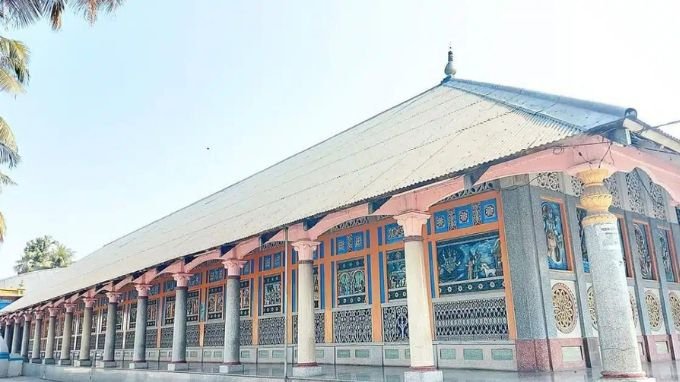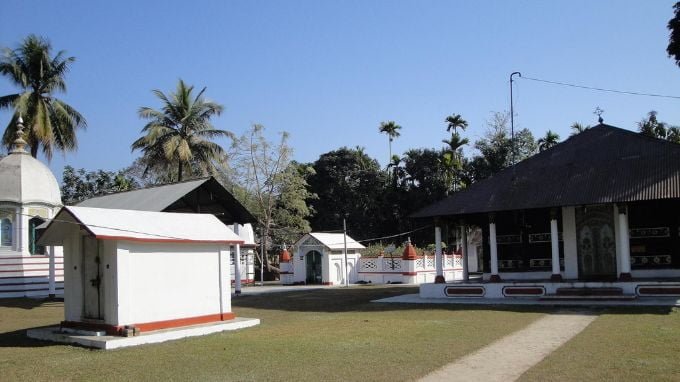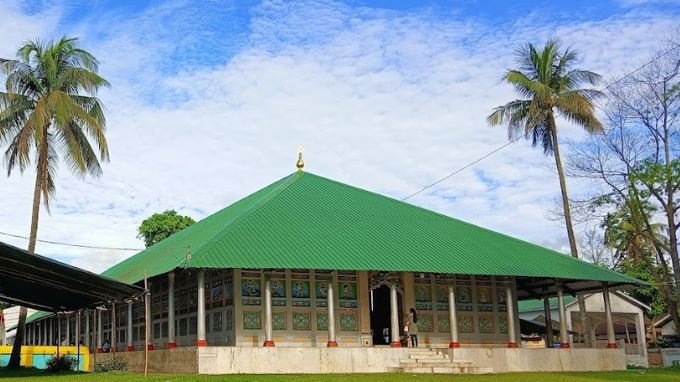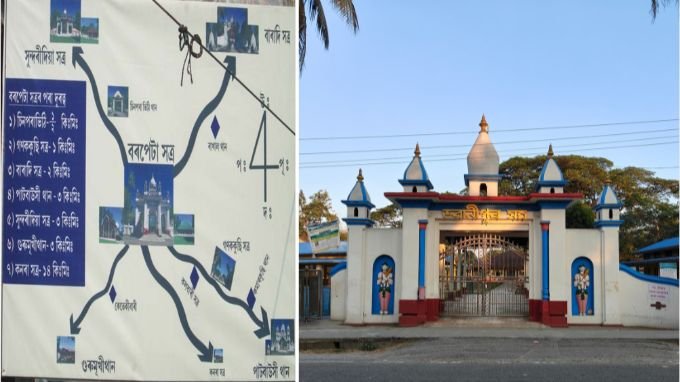Barpeta district of Assam is known as the “satra nogori” (the city of satras) because of the presence of various satras in Barpeta. Satras are the monastic institution established by Mahapurush Srimanta Sankardeva and his disciples to propagate neo-vaishnavite form of Hinduism (Ekasarana Dharma). Many tourists and devotees visit the Barpeta district every year to learn and understand the unique culture of the satras of Barpeta. In this blog, we will discuss about satras of Barpeta, its history, and culture and learn what makes the satras of Barpeta so unique and important to the culture of Assam.
About Satras of Barpeta
Satras represent a pivotal aspect of Assamese life, deeply intertwined with its cultural fabric. The Satras of Barpeta were established through the endeavors of Sankardev and his followers. Sankardev, accompanied by his disciples, traversed Assam, propagating the neo-Vaishnavite faith. Among his prominent disciples were Madhavdev, Damodardeva, and Harideva, who played crucial roles in this dissemination. They founded satras, or monastic prayer halls, across Barpeta, fostering the spread of their movement.
Typically, the satras of Barpeta comprise a Kirtanghar (Namghar), a Manikut (sanctum sanctorum), a Batsora or Karapat (entrance gate), and surrounding villages known as Hatis. Initially, the satras primarily hosted religious discussions. However, over time, they evolved into influential hubs shaping the broader Assamese society and culture. The origins of various cultural traditions such as Borgeet (traditional devotional songs of Assam), Ankita Naat (traditional dance drama), Sattriya Dance, Bhortaal Nrittya (traditional dance), Paalnam (religious congregation), and more can be traced back to the satras of Barpeta.
Some of the Important Satras of Barpeta are: Patbaushi Satra, Ganakkuchi Satra, Jania Satra, Sundaridiya Satra, Barpeta Satra, Kanara Satra, Baradi Satra, Satra Kanara, Bahari Satra, Gajia Satra and Bhawanipur Satra.
Chinpara Bhithi
Srimanta Sankardev, on his journey from upper Assam to Lower Assam via the river, made a significant stop near the Barpeta bil, a serene lake. Enchanted by the divine aura and sacred signs he encountered there, he felt compelled to stay and propagate his religious teachings in the area. This pivotal decision transformed the locale into a revered site of worship. According to the Katha Guru Charit, the biographical accounts of Srimanta Sankardev and Sri Sri Madhavdev, Sankar Guru resided here for approximately six months, profoundly influencing the spiritual landscape of the region. This sacred site is renowned as Chinpara Bhithi or Chunpora Bhithi, drawing pilgrims and devotees seeking spiritual enlightenment and divine blessings.
Kumarkuchi Satra
From Chinpara, Sankardev embarked on a journey to Kumarkuchi. He resided in Kumarkuchi for nearly a year, dedicating himself to the dissemination of his teachings and the establishment of a spiritual community.
During his stay in Kumarkuchi, Sankardev encountered various challenges and experienced personal loss when his youngest daughter, Rukmini, passed away during the night, plunging him into profound grief. In light of these adversities, Sankardev made the decision to relocate, moving approximately one mile southward with his disciples to Patbaushi.
This transition marked a pivotal moment in Sankardev’s journey, reflecting his resilience in the face of adversity and his unwavering commitment to his spiritual mission.
Note: Chinpara Bhithi and Kumarkuchi initially served as temporary stopping points for Sankardev in Barpeta. Although no formal satras (monasteries) were established there during his time, these locations were later developed into satras by subsequent saints of the Neo-Vaishnavism movement.
The First Satra of Barpeta : Patbausi

During the era when Sankardev propagated neo-Vaishnavism, Assam experienced a phase of political turmoil, compelling Sankardeva to constantly relocate. After moving around (from Majuli in Upper Assam to Kapalabari in Lower Assam ), Sankardev finnaly settled at Patbausi of Barpeta (which was a part of Koch Kingdom then) in around 1543 AD. He constructed a Kirtanghar there and initiated his followers into Ekasarana Dharma.

So, Patbausi or Patbausi Than is the first Satra was established by Shrimanta Sankardeva in Barpeta. It is located 2 km north of Barpeta town. Here, Sankardev spent 18 years of his life with remarkable achievement including completion of the ‘Kirtan Ghosa’ , 4 plays (Rukmini harana, Parijata harana, Keligopala and Kalidamanaand) and composition of 240 number of invaluable Borgeets. These scripts along other tems used by these Gurus and Sachipat puthis are carefully preserved here. Ahom Ruler Pramatta Singha constructed a Math in memory of the saint Sankardev. The Damodar Deva Satra is also located within the same ground.
However, the current condition of the Satra is very poor and poorly managed. Recently, the government has taken steps to preserve this treasure of Assamese heritage and plans to establish a Srimanta Sankardeva Museum on the Satra premises.
Anecdote: At Patbausi Satra, Sankardev entrusted around 240 Bargeets to Kamala Gayan. However, a tragic fire at Gayan’s house destroyed most of these compositions. Following this incident, Sankardev ceased composing Bargeets. Today, only 34 of the original 240 Bargeets survive.
Unlike the Satras founded by Srimanta Sankardev and Sri Sri Madhavdev, Patbaushi Damodar Dev Satra, belonging to Brahma Sanhati, follows distinct customs and rituals.
Barpeta Satra : Most Visited Satras of Barpeta
Barpeta Satra, also known as Barpeta Kirtan Ghar, holds a distinguished reputation as the epicenter of Vaishnavite culture in Assam. It is considered the chief satra among among all the satras of Barpeta and Assam. The satra was established by Mahapurush Madhavdev in 1505 CE. In 1594, the Barpeta Satra was unexpectedly consumed by a forest fire. The kirtanghar reconstructed by Mathuradas Burha Aata later.

The Satra compound covers approx 20 bighas of land. The Satra has several buildings. The front gate is called ‘Batsora’. The main ‘Kirtanghar’ is where prayers or ‘Nam Kirtan’ are performed is an architectural splendour.
Many of the festivals and programs at Barpeta Kirtan Ghar represents tradition and customs instituted by Sankardev and Madhavdev five centuries ago. Of all these festivals, the Doul Mahotsav (Holi), Bohag Bihu (Bohagor Damhi), Birth ceremony of Sri Sri Madhavdev, Tithi of Srimanta Sankardev- Sankardev Kirtan Mahotsav, Tithi of Sri Sri Madhavdev – Madhavdev Kirtan Mahotsav, Krishna Janmashtami, Magh Bihu (Maghor Damhi) are the most prominent.
People from all over Assam visit Barpeta Satra to witness these festivals especially the Holi celebration in Barpeta Satra.
Read this blog for more in-depth details about Barpeta Satra.
Ganakkuchi Satra
This satra was founded by Sri Madhab Deva and the Satra is located within the Barpeta town area (1 km from Barpeta Kirtan Ghar). It was established in the year 1550. The story of establishment of this satra goes like this: Mahapurush Srimanta Sankardev nominated Madhavdev as the satradhikar and asked him to stay here to spread his faith. As ordered by his guru, Madhavdev went on to stay here for 18 long years.

Here, at this satra, Madhavdev composed 191 No. of Borgeet on the direction of Sankardeva. Some of the items used by Madhavdev and Sachipat puthis are well-preserved here. The vithis (residence) of Shri Ram Ata and Shri Ram Atoi are also preserved here.
During Srimanta Sankardev’s final journey to Koch Behar, he paused at Ganakkuchi, spending a night with Madhavdev. It was during this momentous encounter that Sankardev transferred all his spiritual power and devotion to Madhavdev, reaffirming his role as the torchbearer of neo-vaishnavism in Assam.
Sundaridiya Satra
The Satra was established by Madhavdev after leaving Ganakkuchi Satra. Madhavdev resided at Sundaridia for a duration of 14 years, from 1492 to 1505 Shaka (1570-1583 A.D.). It is located 1 km north of Barpeta town. The first satradhikar of Barpeta Satra, Sri Mathura Das Burha Ata initially come to this Satra, and became a disciple of Madhavdev. Mahapurush Madhavdev established the culture of Paal Nam and Bir Nam at Sundaridiya Satra. Further, he composed the “Bhakti Ratnakar” and “Namghosa” here in this satra.

A well dug by Madhavdev is preserved till today and water of the well is considered holy. There are three Guru Asanas (seats of Guru) inside the satra in the name of Shri Sankardeva, Shri Madhavdeva and Shri Badula Ata.
At this satra, notable individuals such as Gopal Ata of Bhawanipur, Barbishnu Ata of Chamaria, Lakshmikanta Ata of Dhopguri, Harihar Ata of Najira, and Mathuradas Burha Ata of Barpeta were initiated into the Sankari religion by Madhavdev.
Jania Satra
This is one of the famous satras of Barpeta. Jania Satra was founded by Narayan Das Thakur Ata, a beloved disciple of Srimanta Sankardev. There are two satras at Janiya- Sri Narayan Das Thakur Ata satra and Purushottam Thakur Ata (grandson of Sankaradeva) satra. It is known that Madhavadeva went to Janiya at least three times in a year with Sri Ram Ata. This satra is located at a distance of 8 km from Barpeta satra.
At Jania Satra, revered relics such as Sankardev’s Kharam (wooden sandal) and Padshila (footprint on stone) are diligently preserved as objects of worship, serving as tangible connections to the divine legacy of Srimanta Sankardev.
Baradi Satra
This satra was also established by Madhavdeva. As Srimanta Sankardev and Sri Sri Madhavdev journeyed downstream from Kapalabari towards Barpeta, they arrived at the serene location of Baradi. Upon their arrival, Madhavdev chose to establish his residence in Baradi. He stayed here for a very short period. The vaishnavite culture spread far and wide from Baradi making it a center for learning. This satra is located about 2 km east of Barpeta satra.
Bahari Satra
Bahari Satra, founded by Sri Sri Haridev, stands as a remarkable institution within the Brahma Sanhati tradition. Haridev, born in Narayanpur of Upper Assam, sought refuge in Bahari, erstwhile Kamrup, to evade persecution by the Ahom king. Settling in Bahari, Haridev emerged as one of the primary religious instructors propagating the creed of Sankardev.
Despite the challenges faced, Bahari Satra flourished under Haridev’s guidance, becoming a prominent center for spiritual teachings and community engagement. Haridev’s legacy endures, with Bahari Satra serving as a testament to his unwavering commitment to the ideals espoused by Srimanta Sankardev.
Kanara Satra
Kanara Satra, located on the South-West side of Barpeta, holds a venerable status as an ancient institution. Established by Narayan Das Thakur Ata, its origins trace back to a time when the Satra was situated near Mandia. However, the devastating earthquake of 1897 reduced the original Satra to ruins. In response to this tragedy, devotees resolutely re-established Kanara Satra near Ganakkuchi.
This relocation marked a new chapter in the Satra’s history, demonstrating the unwavering dedication of its followers to preserve their spiritual heritage despite adversity. Kanara Satra continues to stand as a beacon of faith and resilience, serving as a cherished center for spiritual devotion and community enrichment in the region.
Gajia Satra
Gajia Satra, initially located near Mandia, faced the devastating effects of the great earthquake of 1897, rendering the area uninhabitable. Displaced inhabitants sought refuge elsewhere and eventually resettled in what is now known as Gajia, where they reconstructed the Satra. Over time, the area flourished, evolving into a place of prosperity and growth. The name “Gajia” originated from the emergence of this new settlement, likened to a sprout or new growth.
Narayan Das Thakur Aata played a pivotal role in the establishment of Gajia Satra. References to this place in various charit books indicate its pre-existing significance even before the formal establishment of the Satra. Gajia Satra stands as a testament to resilience and renewal, embodying the enduring spirit of its inhabitants despite adversity.
Bhawanipur Satra
It is located far away from Barpeta town (17 km from Barpeta town). It was established by Gopaldev or popularly known as Gopal Ata.

FAQs Regarding Satras of Barpeta
Q: Which is the first satra established by Srimanta Sankardeva in Barpeta?
A: Patbausi Satra (located 2 km north of Barpeta town) is the first Satra was established by Srimanta Sankardeva in Barpeta.
Q: How many Borgeets did Sankardev composed?
A: Sankardev composed a total of 240 borgeets. However, a tragic fire destroyed most of these compositions. Today, only 34 of the original 240 Bargeets survive. Following this incident, Sankardev ceased composing Bargeets.
Q: Who established Barpeta Satra?
A: Barpeta Satra was established by Mahapurush Madhavdev.
Q: When was Barpeta Satra Established?
A: Barpeta Satra was established in 1505 CE.
Q: Who was the first satradhikar (head of satra) of Barpeta satra?
A: Gopal Tanti alias Mathuradas Burha Ata was coronated as the first satradhikar of Barpeta satra on the tithi (death anniversary) of Sankardeva in 1595 CE.
Q: In which Satra, Sankardev finished writing Kirtan Ghosa?
A: Patbausi Satra
Q: Who established the tradition of Paal Nam and Bir Nam?
A: Mahapurush Madhavdev established the culture of Paal Nam and Bir Nam at Sundaridiya Satra.
Q: In which Satra, Madhavdev composed Nam Ghosa?
A: Sundaridiya Satra
Q: How many satras are there in Barpeta town?
A: There are 7 main satras in Barpeta. They are Patbaushi Satra, Ganakkuchi Satra, Jania Satra, Sundaridiya Satra, Barpeta Satra, Baradi Satra, Satra Kanara. However, there are many sakha-satra (branches of main satra)

















